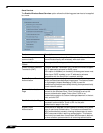
Thinking Critically About VAPs
365
SonicOS Enhanced 4.0 Administrator Guide
Thinking Critically About VAPs
This section provides content to help determine what your VAP requirements are and how to
apply these requirements to a useful VAP configuration. This section contains the following
sub-sections:
• “Determining Your VAP Needs” section on page 365
• “A Sample Network” section on page 365
• “Determining Security Configurations” section on page 366
• “VAP Configuration Worksheet” section on page 366
Determining Your VAP Needs
When deciding how to configure your VAPs, begin by considering your communication needs,
particularly:
• How many different classes of wireless users do I need to support?
• How do I want to secure these different classes of wireless users?
–
Do my wireless client have the required hardware and drivers to support the chosen
security settings?
• What network resources do my wireless users need to communicate with?
–
Do any of these wireless users need to communicate with other wireless users?
• What security services do I wish to apply to each of these classes or wireless users?
A Sample Network
The following is a sample VAP network configuration, describing four separate VAPs:
• VAP #1, Corporate Wireless Users – A set of users who are commonly in the office, and
to whom should be given full access to all network resources, providing that the connection
is authenticated and secure. These users already belong to the network’s Directory
Service, Microsoft Active Directory, which provides an EAP interface through IAS – Internet
Authentication Services
• VAP #2, Visiting Partners – Business partners, clients, and affiliated who frequently visit
the office, and who need access to a limited set of trusted network resources, as well as
the Internet. These users are not located in the company’s Directory Services.
• VAP #3, Guest Users – Visiting clients to whom you wish to provide access only to
untrusted (e.g. Internet) network resources. Some guest users will be provided a simple,
temporary username and password for access.
• VAP #4, Frequent Guest Users – Same as Guest Users, however, these users will have
more permanent guest accounts through a back-end database.


















